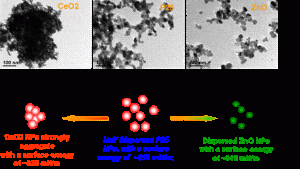Nanotechnology has many applications but toxicity of nanoparticles has become of increasing concern in recent times. Recent research shows that depending on their surface chemistry, size, surface area, crystallinity and surface charge, nanoparticles can produce toxicity on cells via different mechanisms. In this work, we focus on developing techniques to monitor hydrophobicity/wettability and to correlate it with toxicity. Since traditional techniques are not quite valid at the nano level, we have developed a new technique based on measuring trace water adsorption to quantitatively evaluate the hydrophobicity of the nanoparticles.
This technique is able to yield surface energy values for different types of nanoparticles and values correlated with the effects on Nitrosomonas Europaea bacteria cell morphology (X. Fang, B.Li, I. Chernyshova, P. Somasundaran, “Ranking of as received micro/nano particles by their surface energy Values at Ambient Conditions”, Journal of Physical Chemistry C, in print).

